371 Hours Played on PC, Currently Level 526, SR = TBD (0/10 matches) - Highest SR = 3040 in Season 12, Mains = Genji, Lucio, McCree, Ana
Don't wanna be here? Send us removal request.
Text
Every Ultimate Ability (part 2)
I’ll be continuing right where I left off, with Mercy’s Ultimate.

Valkyrie does a few different things, mostly making it easier for Mercy to stay alive longer while doing more healing.

For example, her healing and strengthening beams can stretch much farther (2-3x times as far), and they also chain between your teammates. If you heal one person in a crowd of 3, then everyone in that crowd is also healed.
Something else worth mentioning is that Mercy’s able to fly in a pretty controlled way while the Ultimate is active. For the ~20 seconds, Mercy can evade a lot of enemy attacks as long as the player moves erratically. This all fits well with Mercy’s character and kit because her wings and staff are two of her biggest tools, so it makes sense that her Ult uses both of them.

In the past, Mercy had a VERY recognizable Ult, called Rezurrect. “Rez,” as it was called, gave Overwatch the line of “Heroes Never Die.” Although the Ultimate was replaced with Valkyrie, many heroes still know Mercy by this iconic voice line and her ability to turn an entire team fight around just by hiding and pressing Q.

Moira’s Ult, Coalescence, also fits pretty well with her character. In it, Moira shoots out a huge beam of light from her hands, carrying over her 2 hands’ abilities: “One hand gives, the other takes.” Whenever the beam comes in contact with an enemy (it goes through their barrier shields), it deals damage at a pretty decent rate. When it hits a teammate, it heals them at a pretty nice rate as well.

Because the Ult goes through enemies shields and it can go through multiple people in game, Moira can get a lot done with her Ult. In fact, because she’s healed over time while its activated, Moira can be damaging or healing every single person in the game (if they all lined up perfectly). As you can see in the picture, I was able to heal the training bot in front of me while also eliminating an enemy bot (the small explosion in the background).

Orisa’s Ultimate, Supercharger, is basically just a huge damage booster. She places it down when activated, and it boosts the damage of her and all of her teammates, as long as they stay within its line of sight; if you go behind a wall, you lose its benefits. The Supercharger can be destroyed pretty easily, so it would make sense to use a shield and covering fire to keep its effects active. Obviously, the damage boosting should help to defend the “Congo drums,” as they’re usually referred to.

Pharah’s Barrage is a very simple Ultimate. When activated, Pharah stops in the air, disables all movement and other abilities, and begins spewing out rockets wherever she’s aiming.
Barrage is commonly used in coordination with things like Zarya’s Graviton Pulse, because its most effective dealing damage to multiple enemies at once. Also, since its very easy to kill Pharah during Barrage (she stays completely still for several seconds, and practically glows like McCree), its usually used with a pocket healer: a teammate who focuses healing or other benefits on you.

Reaper’s Ultimate Death Blossom matches his character pretty well: a very disturbed and demented dead man, screaming “DIE” multiple times while shooting all around themselves makes a lot of sense.
Death Blossom deals a lot of damage in a very close range radius around Reaper, so it has to be used in a very good position. Because of this, if players notice a Reaper sneaking around or pushing very awkwardly, they’ll assume he’s about to use his Ult so they’ll spread out; similar to the procedure to follow during Junkrat’s Ult, except this time you’ll have some time to react.

However, if the Reaper player successfully sneaks around the enemy team (using teleportation, like in the photo, or just crouching on the sidelines), he can easily kill of many of them before someone has a chance to react or run away. In the past (as I’ve mentioned before), Death Blossom was used in combination with Ana’s Ult to perform the “Bey-blade Strategy.” Although Ana’s Ult no longer provides a speed boost, a Lucio’s Amp-It-Up ability on the speed setting will usually do the trick, which allows Reaper to chase down any enemies trying to get away.

Reinhardt’s Earth-shatter also fits his character very well. As the definition of a tank hero who happens to wield a giant hammer, Rein slams his “Hammer, Down!” which stuns any enemies in its path for a few seconds. However, because its blocked by other shields, it’s a tricky Ult to do a lot with.
When an Earth-shatter is executed well, it can be used in coordination with other abilities like DVA’s Self Destruct to completely wipe the enemy team, usually resulting in the capturing or securing of a point or payload.

Similar to the last two Ultimates, Road Hog’s Whole Hog fits his character perfectly. As a giant man wielding a junky scrap gun, Road Hog jams a giant crank onto the side of his gun, allowing him to spew plenty of springs, rocks, and whatever else he slams into the top of his gun at enemies.

As you can see in the photo, Whole Hog does a lot of knockback with its pellets, and it only gets more intense the more you hit the enemy. If the enemy is invulnerable or has a lot of health, they’ll live on as they’re flown far outside the map boundaries, or just into the corner of a room. With the insane amount of damage the Ultimate does, its balanced by being inaccurate (spreads very far horizontally), and is one of the only things in the game that has recoil the player can account for by pulling their aim down. The Ultimate lasts for a bit more than 5 seconds, and ends with the gun falling apart, the crank not able to be used until the ability is charged again.

Soldier’s Ult, Tactical Visor, is another very recognizable Ult, and has a voice line as unique as McCree’s “it’s high noon.” In it, Soldier gets aimbot for a few seconds, where all bullets fired will hit an enemy (assuming they’re in your line of sight, and not being protected by a shield).

As you can see in the photo, the player’s view is dramatically transformed, and each enemy is given a small reticle over their player model. Whoever the player’s crosshair is closest to gets targeted, shown by the large white arrows around the training bot on the right. When that enemy is eventually eliminated, it will switch to the next closest enemy, and if there are none, it will shoot as if the Ultimate wasn’t activated.
As you can also see, Soldiers abilities are not restricted during the Ultimate. In fact, if you use the healing aura and start Tactical Visor at the same time, Soldier can be healed for a little bit during his aimbot. Also, during the Ultimate, reloads are made almost instant, making Soldier’s potential during this time increase even more.
Unfortunately, I’m going to have to stop there once again. There’s about a third of the characters left to finish, which I’ll cover next week. After that, I may be covering map flow and dynamics, although I’m not sure yet. See you then!

1 note
·
View note
Text
Every Ultimate Ability (part 1)
Ultimate abilities are what make or break games at all levels of play. Maybe a quick combination of them finishes off the game at a low level of play, or an entire “ultimate economy” is built to determine team fights and the match as a whole depending on the very first fight of higher levels of play. In general, Overwatch revolves around its Ults; and there’s plenty.

These are the 29 heroes currently in the game, and they all have their own ultimates. Although some are similar, they’re all as unique and especially recognizable as the one before it.
In fact, every ultimate has its own voice line, which lets you know its on the way.
youtube
In this video, all of the (original) voice lines are covered, as well as a few skin-specific ones (Hanzo’s wolf skins, for example, have wolfs instead of dragons).
First up, Ana’s Nano Boost.

Nano Boost gives a friendly player a very bright glow (blue to friendlies, orange for enemies), as well increased damage done and reduced damage taken.
Nano Boost is very commonly used in coordination with other offensive ultimates to make it worth the time put into charging it. Offensive ultimates that work well with Nano Boost include Genji’s Dragonblade, Soldier’s Tactical Visor, and Reinhardt’s Earthshatter.
In the past, Nano Boost gave the friendly player a speed boost along with its original benefits, and allowed Ults like Death Blossom to work very well (”Beyblade” strategy, I’ve mentioned it before).
In a rather recent update, Nano Boost was made available to Ana in Free For All matches, letting her boost herself so that it wasn’t useless.
Ashe’s Ultimate, B.O.B. summons an NPC; not surprisingly, his name’s Bob.

Although I haven’t really played with Ashe much, I know generally how the ultimate works. When it’s casted, Ashe launches Bob into the battlefield, where he’ll fight wherever he lands until no enemies remain or he’s defeated (he has quite a bit of health). After he sees no enemies, he stands there until his timer diminishes, and then he leaves the battlefield.
Bastion’s Ultimate allows him to reconfigure himself in another way, into a Tank.

While in the transformed state, Bastion is allowed movement as normal (speed is consistent, animation definitely isn’t), and replaces his weapon with a rocket launcher. The explosions cause massive amounts of damage, able to instantly kill a 200 HP hero if the shot hits them directly, or hits extremely close to them.
Abilities are still available, so Bastion is able to self-heal during his ultimate. Because rockets do blast entities away from the explosion, rocket jumping is made viable, and his ability to heal makes this even more efficient.
Brigitte’s Ultimate is Rally, and I still hate her (even her ultimate steals from other characters, and its generally too aggressive like the rest of her playstyle).

Rally gives Brigitte increased speed, and it develops permanent armor on teammates in its radius. That’s pretty much it. It lasts for around 10 seconds and like I mentioned before, the armor is PERMANENT, meaning it lasts until it is shot off by enemies. It also stacks with the armor she manually gives to her teammates.
DVA’s Ultimate, Self Destruct, is very situational but can be very powerful if done well.

Self Destruct simply explodes her mech after a few seconds, and kills any enemy within its line of sight inside a specific area (a radius around the exploding mech). Thrusters continue to act on the mech as it’s exited during the ultimate, so the bomb can be launched onto a point or over a rooftop to surprise enemies.
However, anything can block its damage, whether it be a Zarya Bubble or a lamppost that an enemy is barely hiding behind. Because of this, the DVA player must get rid of any protections the enemy team has before launching her nuke in.
Oh, and also, the Ult can be activated while DVA is exiting the mech normally, so it can be used as a panic button if DVA wants to ensure death for her killer.
Doomfist’s Ultimate, Meteor Strike, is very basic, but it continues his play style and general theme very well.

Meteor Strike slams Doomfist down wherever he pleases and damages any enemies within its area. The amount of damage is massive, able to kill almost any hero in one shot, but its area of effect is rather small, so its difficult to use well.
Genji’s Ultimate, Dragonblade, is one of my personal favorites (technically, I’m still a Genji main), and for good reason.

When cast, Dragonblade unsheathes Genji’s traditional sword and allows him to use it for around 8 seconds. Movement speed is slightly increased, and his abilities are able to use as normal, so dashes are very well involved. 2 of his “swipes” can take down most heroes, but combinations of fast dashes reset by eliminations allow him to do much more damage.
Since he’s my main, I’ll include a personal video of mine to go along with this, so that you can see it in action.
youtube
Hanzo’s Ultimate, Dragonstrike (yes, the name’s very similar to his brother’s) casts his “Dragon of the South Wind,” and does massive amounts of damage if placed correctly.

As I mentioned before, Hanzo’s wolf skins changes the look and sound of the Ultimate, meaning that my version includes wolves instead of dragons, but the function is the same regardless of what skin you’re using.
Once the ultimate is successfully cast and very recognizable voice line is over, Hanzo’s dragons move through the map wherever they were aimed, and do mass amounts of damage to any enemies stuck in it.
Although movement isn’t restricted, enemies take so much damage that getting stuck in the middle is almost guaranteed to kill you. Because of this, using something like Halt! from Orisa or Zarya’s Ultimate (mentioned next week) is made very successful because almost nothing can protect you from Dragonstrike’s damage (besides things like Wraith Form from Reaper or a Zarya Bubble, but those are both rather temporary, especially Zarya’s Bubbles).
Junkrat’s Ultimate RipTire is probably the loudest thing in the game, and for good reason (it fits him very well, after all).

After Junkrat let’s the tire loose, the player loses control of Junkrat (who just stands there) and begins driving the RipTire around. The tire is driven by the player into as many enemies as possible, and explodes on command, doing mass amounts of damage to anyone in its radius not being protected by a shield, assuming it isn’t shot down before then.
The tire has 100 health, meaning it dies pretty easily, especially with its rather large hitbox and very loud, recognizable noises which it emits almost constantly. However, the controlling player (if skilled) can run the tire into walls, make zig-zags, and do other maneuvers to make less noise, and make it harder to hit.
Lucio’s Sound Barrier is a very powerful ultimate ability, able to undo a lot of damage done by other offensive ultimates.

When Lucio touches the floor (he’s lifted slightly by the Ultimate, giving time for enemies to stop him), a continuing blast radius adds about 800 shields to nearby teammates in his line of sight. The shields decay quickly if no damage is done, meaning that the effects are only active for a few seconds. In those few seconds, every friendly player near Lucio is basically made a Tank, negating a lot of damage from enemy ultimates if timed correctly.
If a teammate enters his line of sight during the decaying process, then they’ll end up receiving shields anyway, even if they weren’t there for the initial “blast.” For example, if someone walks into his area when only 300 shields are left, they’ll receive those shields, and the decaying process will continue normally.
McCree’s Ultimate, Deadeye, is known very well by another name...

Deadeye, AKA “It’s HIGH NOON,” makes McCree slow down a lot, and makes him glow very brightly. Oh, yeah, it also makes him slowly target any enemy he can see, and damage for his shots builds up over time, assuming he isn’t instantly blasted away or killed.
If his damage ramps up enough, he’ll be able to kill enemies in one shot, assuming they haven’t gotten to cover either. It’s surprisingly difficult to describe how it works, so I’ll provide you with a video. In short, the Ultimate is extremely recognizable and easy to counter, but can also be powerful if used well.
youtube
Mei’s Ultimate is one of the scariest in the game, because of the deep feeling of hopelessness you get because you know you are very likely going to die.

The ability, Blizzard, shows Mei throwing her robotic companion out into the fray, where he immediately floats into the air and begins to slow and freeze enemies. If you’re in the middle of its radius, you’re probably screwed. If you’re near the edges, you may be able to run out of it in time.
Once the players are all frozen inside of the radius (after only a second or two), they’ll remain frozen and will continue to very slowly take damage for about 5 seconds, which is plenty of time for Mei’s team to kill pretty much everyone if they work quickly.
Mei just has to really hope Genji doesn’t deflect her companion, or HER team is going to be the ones frozen and, very likely, killed (and humiliated for playing Mei and dying to your own Ultimate). This phenomenon is very common for offensive ultimates, like McCree’s or Hanzo’s.
This has been about 12 ultimates out of the game, and there are still 17 left to go. Because of how much there is to cover, I’ll be continuing this post next week, and MAYBE finishing the week after that, although its unlikely. Also, I don’t want to make you read so much at one time. See ya then!
1 note
·
View note
Text
Skill Development
Although I’ve complained numerous times before that skill should be more important in a game like Overwatch, at the end of the day it’s still the difference between a silver player and a diamond player (unless you play characters like Brigitte). The development of this skill is dependent on playtime as well as the amount of practice you put into the game.

When you first start the game and you have no idea whats going on, Overwatch puts you into the game tutorial, which teaches you the very basic controls and concepts of the game (buttons for movement and abilities, as well as what an objective is). The tutorial tells the player about the very basic game mechanics, but does very little to talk about player interaction or the various characters.

Practicing against A.I. (computer controlled bots with various difficulties) teaches the player about basic team composition through tips and popups telling what kinds of hero a team is lacking. Although the movements and strategies of these bots are very predictable and easy to counter, the game mode does a decent job of educating the player on other core components that the tutorial lacks.

As seen in the tip on the left side of the photo, the practice range allows the player to run around, test abilities, practice aim (I’ll get to that later), and generally learn how to use any hero they want against training bots that don’t fight back (excluding one or two).

These training bots have 200 HP, which is the health of many heroes in the game. This helps players to test different combinations of abilities to see what things would be able to kill enemies in 1 or 2 hits.

Once a new player knows the game mechanics as well as how to use one or 2 heroes (or before this point) they’ll push themselves into quickplay or the arcade, where they can play against human opponents (see my “The Various Game Modes” post).
Through playtime in these modes, a player will both rankup (quickly, relative to future levels of 20k XP) until level 25, where competitive play becomes available. The game expects that by this point, the player will know who most of the heroes are, as well as how to play the game at a decent standard. Whether or not the player actually knows these things depends on how they played the game in these 25 levels. Like future seasons, the player will need to complete placement matches. Unlike future seasons, these placement matches are the only ones that actually place the player in a rank (future seasons just go off of your most recent SR, and don’t do much more than if you just played 10 matches after the last season).

Playing the game (in any mode) teaches the player about abilities, but ultimately it’s up to the player to discover how to play each character properly, and how to win fights with them. Also, playing against heroes shows you their flaws, and therefore what tactics would work against them.

For example, a player would know by going against Roadhog that playing outside of his hook’s range is an effective strategy, especially if you’re playing someone able to do damage from that range, such as McCree or Soldier.
Also, the more playtime someone has would impact how many team strategies they know as well. By playing online with other people, you’re better exposed to advanced teamwork and compositions than if you played exclusively player vs. AI modes, or other arcade game modes.
Another good way to learn strategies and tricks is to search for resources online, my personal favorite being Overwatch YouTubers. One in particular that really helps players learn different heroes is KarQ, who gives many tips for each hero interaction.
youtube
Learning different tips and tricks from YouTube and applying them in game helps you develop your own strategies, and generally win more fights than you would have before.
If tutorials and tricks aren’t your thing, you can also watch professional players play and try to learn from it. For example, many players watch things like the Overwatch League to see full professional matches,

By watching these (and also professional streamers), players may learn whole team strategies, movement around the map, and much more.

My favorite part of skill development (instead of team composition and strategy) is mechanical skill, specifically aim. I’ve played a lot of games on my computer on top of Overwatch, and using the same aim I developed in those games (over 1000 hours on CS:GO and plenty more), I found myself doing pretty well with characters like McCree and Soldier, simply because I had decent aim from those other games.
In order to improve your aim in Overwatch, you have to know what ways you can aim. Specifically, the difference between flicking and tracking (many names for the 2, they mean generally the same thing.
youtube
Heroes with flick-aiming, such as Widowmaker, Hanzo, and McCree will generally have slower fire rates with fast moving projectiles (if not hitscan), which usually deal pretty high amounts of damage. With their aim style, you would quickly “flick” with your mouse to hit fast-moving opponents, as you could see in my highlight video, making a good McCree a death sentence to an enemy tracer. Although tracking and other types of aim are involved, all you need to worry about is hitting your shot right when you shoot it, so flicking will generally provide the best results.

Tracking-aim is pretty much the opposite, where the player will keep their crosshair (the “plus” in the center of the screen) on an enemy to continue doing damage. Heroes that require tracking aim include Tracer, Zarya, and Soldier: 76. Tracking can be considered more difficult because you have to anticipate and react to enemy movement very quickly, which can be very difficult if the enemy’s movement is unpredictable.
Overall, an Overwatch player builds their skill by simply playing the game, which allows them to learn new strategies and how to use or go against new heroes. If they struggle with things like aiming or combos, things like the practice range and custom games (and quickplay, I guess, just don’t practice in competitive or you will be yelled at) exist to allow the player to practice and become a better player. Next week, I’ll be covering every single Ultimate Ability in the game.
1 note
·
View note
Text
PTR and Updates
Like all other mainstream games, Overwatch is actively supported by its developers. The changes and additions to the game they make are applied through updates, which vary in size. Some updates will patch a few minor glitches, and others (like the Seasonal Events) add entire maps, characters, or just a lot of cosmetics. Some of these updates are rolled out onto the PTR edition of the game (Public Test Region), only on PC.
Upon starting the Blizzard Launcher (how you get to the game on PC), you may select what game region you want to play in.

As you can see, there are different world regions (varying connection strengths, of course you’d play in the Americas servers if you live in the US), but there’s also the “In Development” tab. The World Cup Viewer was recently announced, and it’s independent of the game’s regular update cycle. The PTR, however, is included quite a bit in different patches in the game.
The PTR is used to ensure that something won’t be too over-powered or under-powered, and it also allows players to get early playtime in on a new hero.

Just a few weeks ago, Ashe was announced, and she was initially available to play on the PTR servers. However, for about a week, she wasn’t on the playable version of the game. This week allows players to learn her abilities if they want to, and also helps Blizzard to fine tune any of her abilities which seem too powerful (if they see fit).
Also, once fully released in the main game, she isn’t available to play in competitive for quite some time. This is to ensure that if a player isn’t comfortable using or going against a new hero, they wouldn’t have to worry about their SR plummeting just because of a recent change. This gives time for the community to fully learn the hero in Quickplay and other various modes before taking this knowledge into the competitive environment.

Here we can see a few changes made in the most recent update to the main game. Of course, everyone was more focused on the new hero (Ashe), but these changes will still have an impact. In this case, using the PTR would help Blizzard if there’s a public outrage of Mercy’s changes. Maybe people still don’t like playing her, or she’s become too powerful after the changes seen here.

Sometimes, larger updates (those with more than a few “hot-fixes,” AKA small changes made to heroes’ stats and abilities like the ones above) come with a developer update, uploaded to both the Overwatch YouTube channel, as well as the Blizzard launcher itself. In these videos (every few weeks or so), Jeff Kaplan (Vice-President of Blizzard and Overwatch’s main game designer) tells the community about the changes the Overwatch team is working on, as well as giving any introductions to maps and heroes coming in the near future.
Although the patch notes are available on the launcher itself (the picture shown above), it’s also shown online, at
https://playoverwatch.com/en-us/news/patch-notes/pc/
Giving patch notes to the community is essential, because it let’s players actually know what was changed. Had a developer update not been released and patch notes weren’t uploaded, players would have to investigate all parts of the game to discover each and every small update.
Like mentioned earlier, you have to remember that not all updates are the same. While some contain entire maps and new characters, some of them are very small, and provide only 1 or 2 minor changes. For example, the most recent patch on the PTR version of the game:

Quite obviously, this change alone (this was the only thing in the patch notes for this particular update) wouldn’t be deserving of its own developer update. Another thing to not is file size. A patch like this would be able to download very quickly, because the changes made are very likely changing a “1″ to a “2,” or something else very small.

Meanwhile. patches like this one (16 days earlier), would probably have a much larger file size, because a lot of new assets, textures, and voice recordings are added all at once. If the player doesn’t have the game set to update automatically and in the background, they could be waiting a long time before being able to play when they want to, especially if they have a bad internet connection.
However, sometimes an update doesn’t all come out as once, which would result in “leaks” of information. However, this doesn’t usually happen, as there’s almost always SPECULATION as to who a new hero is going to be, as Blizzard does a pretty good job of keeping their secrets, unless its in a developer update of course. In these videos, Jeff might give a hint as to who the new hero is going to be, which they usually announce before hand (i.e. “We’ll soon be welcoming hero #29 into the game! (or something like that)).

With Hammond, released back in late July, Jeff might have said something like “a new furry friend...” in the developer update, telling the community that an animal is going to be the next hero added to the game.
The PTR system is used to test out new abilities and changes, to ensure that the tuning of stats in the game wouldn’t be too extreme or invasive. Both the PTR and the Developer Updates tease new heros, or let players get a glimpse of a new map before it fully comes out. Next week, I’ll be covering practice and playtime, which are the 2 main things relating to the development of skill in Overwatch.
0 notes
Text
All About Combos
Overwatch is a strategic game. Even if there’s characters (Brig) that go against many forms of strategy, the winning team will be the one able to adapt best to the enemy team, and choosing the right characters to do so. Apart from general team composition, combinations of 2 or 3 heroes or abilities can get the job done.
First, I’ll cover character combinations, as that’s the first thing you’ll think of when you see a specific character chosen in the preparation time.
Pharmercy - Pharah and Mercy

Pharmercy is one of the most popular character combos, and it usually works decently if not countered directly. In this combo, Pharah continues to stay in the sky using her abilities, and Mercy repeatedly uses “Guardian Angel” (flying to a teammate every few seconds) and “Angelic Descent” (fall slowly) to stay in the sky with her, while healing and damage boosting whenever she can.

The only way to efficiently counter this combo is to focus them down, usually with a hitscan hero. In case you don’t remember, a hitscan character is someone whose bullet/projectile travels instantly, making hitting moving targets slightly easier, but precision is involved. An example of this would be McCree.
“Pirate Ship” / Bastion Comp - Bastion with Shields

This is a very situational and stationary combination of heroes, and is usually defending a point, or is set up on the payload. Quite simply, Bastion is put into turret mode behind one (or 2) shields, and is made difficult to take down. While the shields are active, Bastion has plenty of protection and can deal huge amounts of damage to his enemies easily.

Unless your team’s damage can rip through the shield, the best way to take the bastion out is to flank behind him, or get rid of the shields in someway: Mei’s Ice-wall, Sombra’s hack or EMP, or just a lot of damage. Mobile heroes like Genji and Tracer also do decently against this combo.
Other kinds of combos in Overwatch are ability and ultimate combinations, and are much more common. In fact, 2 really good ultimates can force a character combination to work, even if those characters wouldn’t regularly work well with each other.
Ana’s Nano Boost ability is all about combination. In fact, it’s rarely ever used unless there’s another ultimate on the team that it works well with.
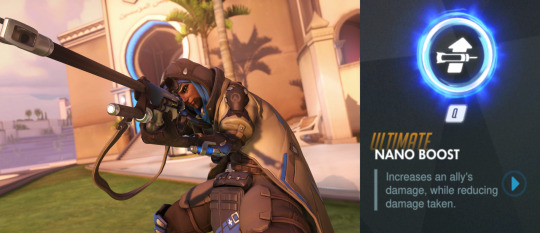
Nano Boost gives the recipient a very obvious glow (blue or orange, friendly or enemy), as well as the benefits shown in the picture above. It is used well in conjunction with multiple Ults to usually provide team-wipes in seconds.

A few of my personal characters to use in conjunction with Nano Boost are Genji, Soldier 76, and Reinhardt. However, these aren’t the only characters who have functional Ults with Nano Boost, as almost any offensive Ultimate is improved greatly by it.
Graviton Surge, Zarya’s Ultimate, is in a very similar situation when compared to Ana’s Ultimate. Like hers, it works well in conjunction with offensive Ultimates (some of them), but can also be used without that level of coordination.

Graviton Surge is one of the most useful Ultimate abilities, in my personal opinion. As you can see, Zarya shoots a mini-black-hole which pulls enemies caught in its grasp together into a small area. This works especially well with Ultimates that do massive amounts of damage to provide easy team-wipes.

Some of the more popular Ultimates to use with it is Hanzo’s Dragon-strike, Pharah’s Rocket Barrage, and Tracer’s Pulse Bomb. However, as mentioned before, sometimes another Ultimate sometimes isn’t entirely necessary, and many eliminations can be done with just Graviton Surge and focused fire.
The combination of Reaper’s Ultimate, Wraith Form, and speed benefits is a weird one, but has definitely worked.

This is useful because it allows Reaper to reach the enemies that run away from his Ultimate, which he wouldn’t be able to get to otherwise. Nowadays, this is commonly done with Lucio’s Amp-It-Up ability while speed boosting.

However, in the past, there used to be a way to use Ana’s Nano Boost ability in the same way, and it would have devastating effects. This combo, referred to as the “Beyblade” strategy, was one of the reasons Ana’s Ultimate was changed to the way it is today.
A situational combination includes DVA’s Ultimate, Self Destruct, and multiple other abilities which allow it to be more effective.

DVA’s Ultimate is usually countered pretty easily, usually just by standing behind walls. However, if there are none to hide behind, your enemies may find themselves behind their Reinhardt’s shield. The key to these combos is to stun or disable the Reinhardt’s shield (or get rid of Orisa’s shields) right before the blast goes off.

A very similar effect can be seen if you do the same with McCree’s Ultimate, Deadeye (a.k.a. “It’s High Noon”).
These are just some of the combos in Overwatch, but are many of the popular ones that quickly came to my mind. Combinations can be found almost anywhere, even if it’s just between 2 abilities ready in seconds. Next week, I’ll be discovering the PTR edition of the game, as well as the new features (and new hero) that have come with the most recent update.
0 notes
Text
All About Highlights
Last week, I covered cosmetics in Overwatch, but really only the skins and a few other things. Another big part of cosmetics, which has quite a bit extra to talk about, is the highlight system. This includes the cosmetic portion, the Play of the Game, as well as recordings, which is a feature I especially enjoy having.
One of the last types of cosmetics you can unlock for any character are the highlight intros, which show up in any type of highlight you’re watching.
youtube
These highlight intros are unlocked just like all other cosmetics, and are all in the “rare” category (pink), and therefore cost 250 currency to buy. Like other cosmetics, there are seasonal highlight intros, such as Genji’s “Pumpkin Carving” from the Halloween events.

Each character has about 4-7 highlight intros to choose from, and they’re almost all unique. Similarly to other cosmetics, there are default highlight intros called “Heroic,” in which the character will usually just stand there, and maybe move their weapon a little bit.
The Play of the Game (POTG) is quite a phenomenon. Sometimes, it highlights the coolest part of a match, a huge showcase of perfectly targeted shots. Other times, the system fails, and only shows lack luster gameplay from a boring part of the match, where the receiver of the POTG only gets 1 or 2 kills.

POTGs are saved automatically, and will show up in a days “Top 5 Highlights.” The importance of each POTG is calculated according to healing, damage, and that sort of thing. Quite obviously, someone healing 350 damage per second will get play more often then someone only doing 150. The line between damage and healing done is somewhat blurred, and at times it can feel random.
POTGs are shown to all players at the end of the match, right after the victory poses are shown:

and right before the endcards are shown:

POTGs are about 10 seconds long, and use Blizzard’s set-in-place algorithms to find a player who did a lot of damage or healing in those 10 seconds.
Highlights are Blizzard’s method of “capturing the moment,” and it does it well. You can manually take 3 highlights per match using a keybinding (customizable), and each one saves the last 10 seconds or so as a highlight. Whereas the Today’s Top 5 only stays for 24 hours, these saved highlights expire after a much longer time, somewhere between 1 week and a month.

As you can see in the screenshot, the highlight menu shows all of your recently captured and saved highlights. From this menu, you can rewatch any of the captured highlights as long as they’re there, according to your game’s settings.

As you can see from the bottom of this photo, you can also review any recorded highlights on your computer. Also, at the top, is the menu for saving a highlight to your computer. Using the gear icon, you can change settings for the highlight including whether or not the signature POTG theme plays, resolution, framerate, graphical quality, and more.

After using this menu, a highlight will be saved in a file form on your computer, so you can upload it to YouTube, edit it into a montage, and more. When you combine this with the system to capture a highlight, it makes it pretty easy to get visual content from the game. Problem is, the file saves with a highlight intro (as shown below) as well as a long, dark Overwatch logo afterwards.

(note that the highlight intro says “Highlight,” instead of saying “POTG”)

Although a match’s POTG will show up in a Today’s Top 5, the game will also record other high damage plays automatically, in case it wasn’t quite POTG worthy.
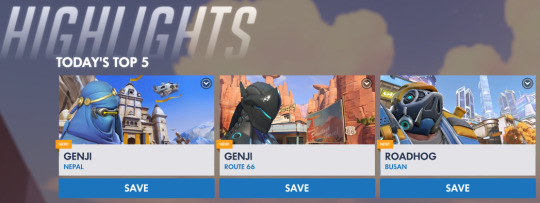
In these 3 examples, I did good amounts of damage, but someone else did more so I didn’t quite get POTG. Had I gotten it in one of these highlights, there would be a little orange label saying so.
One thing to note about this system is its inconsistency. Although it’s pretty lenient as to how a POTG is selected, it doesn’t take into account rare occurrences, huge amounts of eliminations (if an enemy has low health, it might not matter as much), etc... To combat this, it’s important to save things manually if you’re worried that it won’t automatically be recorded.
One example of this would be a goal I scored on Lucioball which I really liked.
youtube
Although this could have easily been POTG (Lucioball makes those calculations differently, because pretty much any goal can be Play worthy), it didn’t quite make it, so I had to record it manually. It wasn’t guaranteed a place in my Top 5 for that day, because it was already full of other plays, which the game might have considered more impressive.
Overall, highlights are a nice quality-of-life feature of Overwatch, which I especially enjoy. When crazy things happen, the game isn’t going to care, but having the ability to record 3 of these moments in any given match is amazing. Not to mention, the actual recording process is simple, easy to customize, and easy to share. Next week, we’ll be pushing away from cosmetics, and I’ll be focusing on Combos in Overwatch, including ultimate ability combinations, as well as ultimates that counter other ultimates.
0 notes
Text
Cosmetics
In Overwatch, you unlock new “skins,” voice lines, and more as you play, and as you participate in events. Today I’ll be going over many different aspects of this system, as well as a short gallery of skins from various events.

A loot box is the center of Overwatch’s cosmetic system. It is through these that you unlock new cosmetics, and with the exception of achievements and events, it is the only way to do so. You earn 1 loot box every time you level up (20,000 XP, likely 10-20 quick play matches), but you can also get them through the arcade. However, you can also buy lootboxes with real money, but I wouldn’t advise doing so.

As you can see, the shop currently offers Halloween Loot Boxes, because we’re in the event right now. Let me explain.
As I’ve mentioned before, Overwatch’s events are seasonal, and they include the Summer Games, Halloween Terror, Winter Wonderland, and more.

While these events are active, you earn 1 free loot box from that event just by logging on during it, and any loot box you earn in that time will be given to you in the form of that event’s loot box. Theoretically, you could earn loot boxes from every event and never open them, and at any point in the year you could earn a Winter Wonderland skin, for example, by finally opening that loot box.

This is an example of what an opened loot box looks like. As you can see, each one gives you 4 items, and they range in rarity. Gray is common, and only contain voice lines, sprays, and things of that sort (not skins). Next is blue, uncommon, which has player icons and some skins. Pink is rare, and has emotes, highlight intros, and skins. Last is yellow/gold, legendary, and it has many skins for all heroes and a select few highlight intros and emotes.

As you can see, this item was a duplicate for me. This is because at the rank I’m at, I own all of the regular blues (not from any events), as well as the uncommon items from the Halloween event. If there was any blue rarity items I didn’t own, I would have gotten those instead. Because there’s nothing left to give me, the game gives you their “currency,” which is used to buy any select item, given that you buy it during its event.

The prices for these items work in different ways. As you can see, the skin on the bottom is unavailable for purchase, because we’re not in the winter-time event yet (shown by the symbol on the left). Once that time rolls around, the item will be available for 1000 credits. Any regular legendary, the one at the top, has a base value of 1000 credits, this value changes according to rarity (i.e. default rare price is 250 credits). As for the skin in the middle, it costs 3 times as much as a regular legendary, because it was introduced in this current event, this year (had it been introduced 1 year ago, it would have returned for 1000 credits like the one on the bottom will).

Credits can also be gained through currency drops, which happen every so often in loot boxes. Each currency drop has its own rarity, which controls how much you will get out of it. This is considered one of the items in an opened loot box.
As I mentioned plenty of times during my character analysis post, voice lines usually have a connection in character. In other words, the voice lines given to each character are made for them, and therefore reflect their personality and are USUALLY unique to that hero. Let’s take a look at some from Mei.

As you can see, many of these are optimistic, and are generally pretty friendly, which reflects Mei’s personality very well. Also, as you can see near the bottom, there are event themed voice lines as well, not just themed skins. The summer ones include things directly related to sports, the winter ones usually involve presents, etc...
Now, the boring parts over. You know how to get these items, and you know how the system works. Now, let’s take a look at some cool event skins, as well as some other legendaries.

Genji’s Blackwatch skin was released during the Archives event quite awhile ago, and it makes sense. The event is all about Overwatch story, and this skin reflects Genji’s involvement in Overwatch in terms of lore.

Probably my favorite Ana skin, Ghoul, was a rare skin released in, you guessed it, the Halloween event.

Like many other Summer Games skins, this rare Mercy skin, Eidgenossin, shows the colors of the Swiss flag, which is Mercy’s nationality.

This new legendary Pharah skin, Enchanted Armor, looks pretty cool. Don’t worry, as she still has a head hitbox (this skin doesn’t prevent people from hitting her in the head).

This legendary Tracer skin, Slipstream, is given to players who buy the Origins or Game of the Year editions of Overwatch, and shows a piece of Tracer’s lore, where she was a pilot in experimental aircraft before joining Overwatch.

This legendary Bastion skin, Avalanche, was introduced during last year’s Winter event. As with many of Bastion’s skins, it changes Ganymede’s form (the bird on his shoulder changes species of bird).

There were also Overwatch League skins, which boasted the color schemes of Overwatch pro teams from different parts of the world. You could buy your favorite team’s colors on any of the heroes in the game, and it would function like many of the other skins.
There’s plenty more to talk about in terms of cosmetics in Overwatch. In a way, it’s what keeps people hooked on the game, as many people get on during events just to get these skins. I’ll be coming back to this topic next week, but I’ll also be moving toward highlights more, as well as play of the game mechanics.
0 notes
Text
Why I HATE Brigitte
This is a post all about Brigitte Lindholm, but not out of appreciation. I HATE her. It’s a strong word, but that’s exactly why I’m using it. If I take every aspect of Brigitte’s character into consideration, my judgement does not change. Any way I look at it, she doesn’t belong in a game this good. Let me explain.
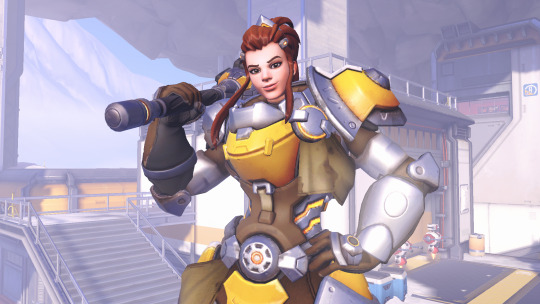
A lot of time, when you get killed in Overwatch, your first thought is “Oh, of course, it’s the ____.” Out of me and everyone I’ve played with, I almost always hear Brig filling this blank. The reason for this is because getting killed by Brig feels cheap, because almost all of her attacks don’t take skill to use.
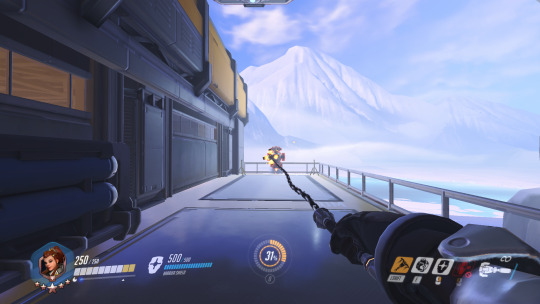
The only exception to this is her Whip Shot, which isn’t even that hard to use regardless, and has some pretty damaging effects.

Let’s start with her most basic ability, her primary attack, the Rocket Flail. In my eyes, Brigitte is built around this flail, as most of her abilities involve it.
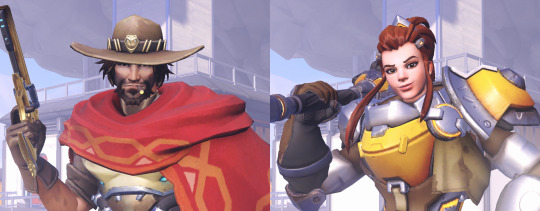
We see a similar thing with McCree, and in both cases the character is defined by the skill dependence of their primary attack. McCree’s Peacekeeper (revolver) takes quite a bit of skill to aim, and only someone who has this skill will do well with it (with the exception of stuns, which I’ll get to later).
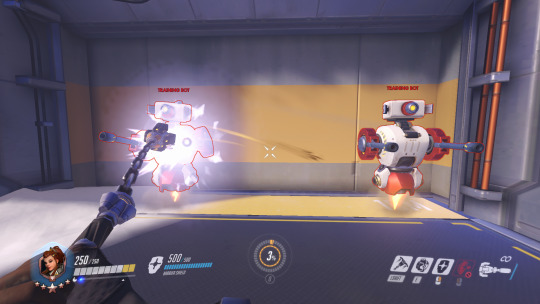
However, with Brigitte, her primary attack is literally melee, meaning that she has to do very little aim with it, as you can clearly see in the photo (both me and my aim are miles away from that bot). Additionally, she doesn’t even have to think about ammo, or anything else that McCree players have to take into account. Also, as the definition says, this attack has a farther range over regular melee, making it even better, which you can also see in the photo.
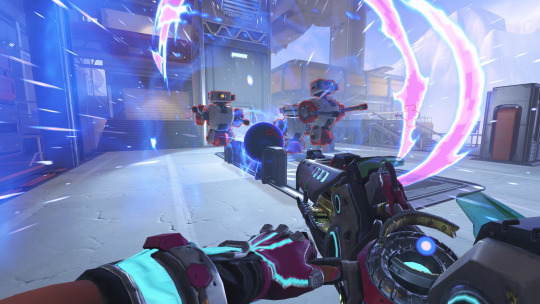
Not to mention, this attack can hit multiple enemies at once, making it pretty powerful in conjunction with thing’s like Zarya’s Ultimate, Graviton Surge. In this case, a Brigitte can have her damage boosted by things like Mercy’s staff or Ana’s ultimate ability (an “Ult”), and could wipe out a team with very little effort.
With many of her abilities coming up next, I really want to prove the point that almost all of Brigitte’s kit borrows (or steals) ideas and functionalities from other heroes. Her ultimate ability, Rally, is no exception.

This ultimate steals almost directly from Torbjorn, her father, and Lucio (and I‘m glad to say that he is miles away from her in terms of story, because I like Lucio). With this, she gains speed (a big part of Lucio’s kit), and gives team mates within a certain radius of her (literally Lucio as a whole) extra armor (from Torb’s old kit) over time, which is permanent. In other words, this armor stays on an ally until it’s hit off of them through damage. Also, armor has benefits in terms of survivability over regular health, making this even worse. Oh, and one last thing. Brigitte isn’t made useless during this time, that would make too much sense for a support hero. Instead, she gets to use all of her other abilities during this time, which just sucks to go against.

Her repair pack ability is almost entirely stolen from Torbjorn and Zenyatta. It has the health benefits of Torb’s ability (+75 armor), and has the simple and easy-to-use targeting system of Zenyatta’s orbs. The main difference from Torb’s is that it prioritizes healing over armor. If the recipient has 25 less HP than their max, then it would fill that 25 health and add on the remaining 50 armor as extra. It has a cooldown of about 6 seconds, which compliments her other healing ability pretty well, because that one’s working almost constantly. In a perfect world, this would be the ability focused most on, since she’s a support hero, who’s meant to heal more than do damage.
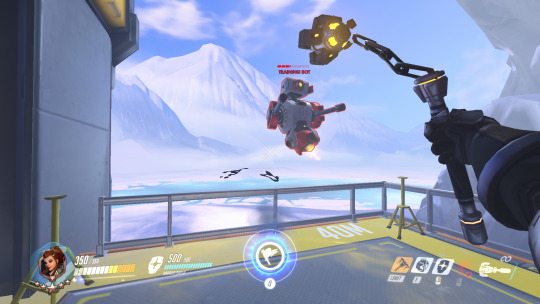
Next up is her whip shot, which is the “skillful” one I mentioned before (because plot twist, you actually need to aim with it). It has the hitbox/usage of Roadhog’s hook when you throw it, and has multiple effects. Although it doesn’t stun the poor soul on the other side of this thing. It does 70 damage (quite a bit), and launches them farther away, very similar to Lucio’s secondary ability.
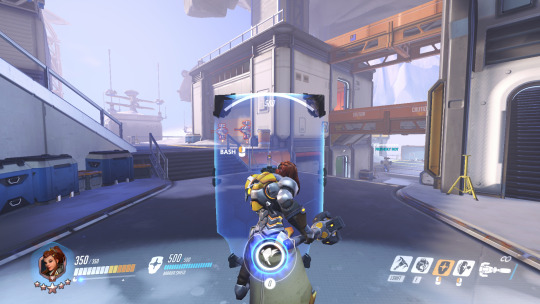
Her barrier shield is pretty much a poor man’s version of Reinhardt’s barrier. It covers only Brigitte, and has 500 health (this is quite a bit, especially when you compare it to a fully healed up Winston). This protects her from the front, but you can simply turn around as you’re using it to block behind you.
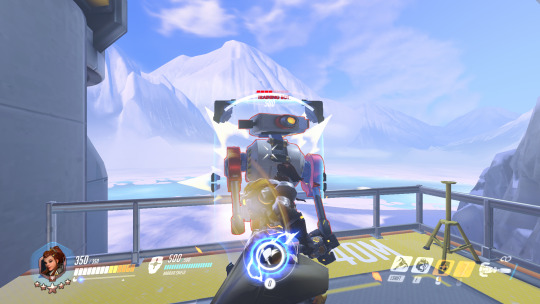
The most hated ability, Shield Bash, simply shouldn’t be in the game. On top of giving her movement benefits (there used to be a way to hit a sloped surface and fly into the air), it does multiple different things. It does a decent amount of damage to another player (50 to be exact) and more importantly, it stuns them. Stuns in Overwatch interrupt a lot of regular abilities, quite a few ultimate abilities, and almost always guarantee death for the recipient, or at least a big loss of health.
While characters like McCree have to use their stuns sparingly, Brigitte can use her quite a bit. The cooldown time of it has increased since her launch, but in my eyes she shouldn’t even have the stun in the first place. It allows her to pretty much kill a Tracer instantly assuming she executes a simple combo well, and it is extremely frustrating to be hit by.
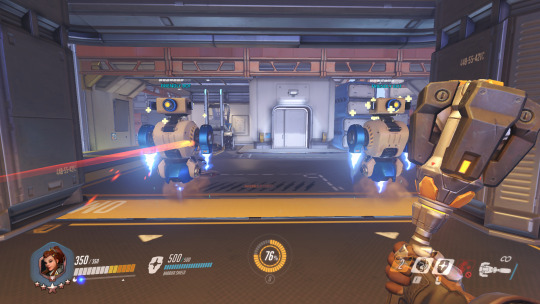
Her last ability, Inspire, is her main healing ability. It heals her and nearby team mates pretty slowly for 5 seconds after hitting someone with one of her flail abilities. For example, you could hit an enemy once, doing 30 damage with melee, then you would heal 5 team mates for 5 seconds each, doing a total of about 250 to 300 healing just by hitting an enemy once, which I’ve shown isn’t that hard to do.
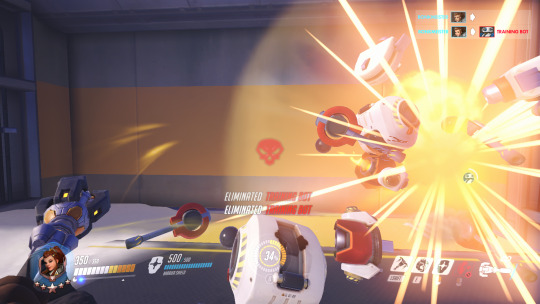
Now, that’s all just been her kit and what she can do. I’ve barely even gotten to the main problems with her, primarily being that in general, she does way too much. Whether you look at her individual abilities or at her role in a team, they all do too much relative to the amount of effort the player must put in.
As a support character, you’d expect her to be the pray, rather than the predator, because that’s usually how it is. However, with her stunning and high damage abilities, this flips that trend on its head.

I like Ana. Her skill dependence pays off well, as her abilities are pretty powerful. However, almost everything about her requires practice or game sense to use. She has long cool downs, which promotes the conservation of her abilities so you wont get “caught with your pants down.” She might be able to take down someone attacking her, but you’ll have to use most of her kit, and use it well.
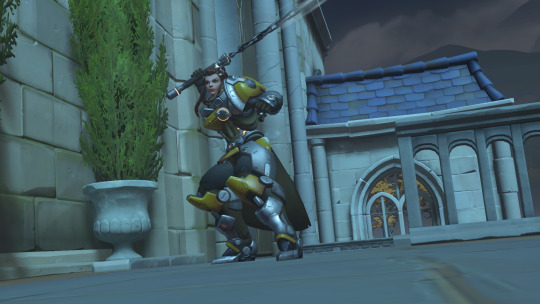
Meanwhile, Brigitte has the same role as a support hero, but instead goes on the offensive, and does that too well. As I mentioned before, she can kill heroes like Tracer and “Baby DVA” (DVA without a mecha unit) with a simple combo, and they have no chance of escaping it. This combo doesn’t make much skill to use, and I can already use it well (I’ll show you why that’s surprising later). Also, the abilities that she has to use aren’t on very long cool downs, sometimes taking half the time to recharge compared to Ana’s abilities, which can take up to 12 seconds.
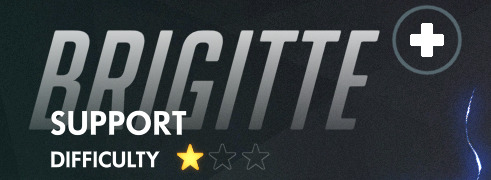
When I say Brigitte is a support hero, that’s just what the game SAYS she is. In reality, she fills pretty much every role in the game, and as I’ve shown, between her healing and her offensive abilities, doesn’t take much practice or skill to do it.
Additionally, the game even portrays her to be easy to play, with a 1 star difficulty rating as you can see in the picture. The point of this difficulty statement is to show that a hero with a lower one will be easy to play, but you won’t get much out of it. Because this system targets new players learning all of the abilities (that’s the page its on), it’s important to show who they may do well with in the beginning.

This is true with someone like Roadhog, who can definitely do work against the enemy team, but at a certain point an amazing Roadhog player can’t do anymore to impact his opponents.
This difficulty statement works to show that Roadhog is an easy character to play, but you probably won’t be turning heads by how well you’re doing.
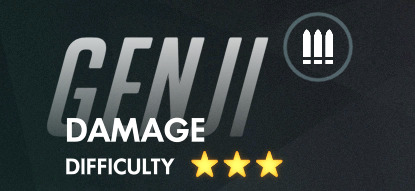
In contrast, a character like Genji takes quite a bit of practice to use correctly, but can cause devastation in the enemy team. The difficulty statement shows this, as you’ll hear of a lot of “Pro Genjis,” while you generally don’t hear the same thing about Roadhog players.
Now, back to Brigitte. Her difficulty works to show that she’s an easy character to play, but fails to say that she CAN do a lot, because the 1 star difficulty generally means that you are limited as a character; at a certain point, you can’t do any more to “turn heads.”
Let’s take a break from gameplay. What about her character?
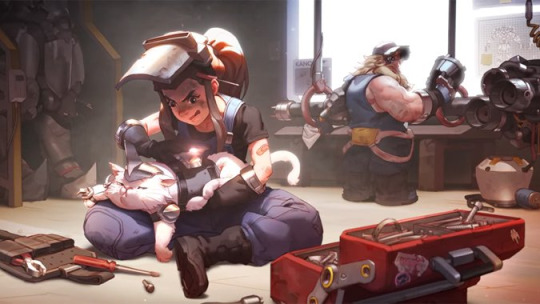
Like her abilities, she borrows a lot from other characters. However, I’ll give her the benefit of the doubt because this is common for other characters: you could say something similar about Genji, whose story involves many other heroes.
As you can see in the photo above, she followed in her father’s footsteps (Torbjorn), and as I mentioned before this is shown in many of her abilities. She always wanted to be an engineer, and now she’s taken it to the battlefield.
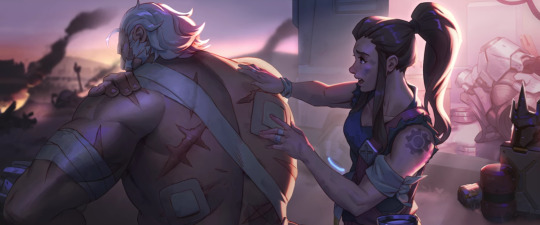
Also, she was a “squire” to Reinhardt, a character who’s had a lot of importance in Overwatch’s story.
Personally, I’m not too mad about her story. She has a few roots in other characters, but doesn’t “invade” too much into the rest of the story. However, in my eyes, a problem arises with her personality and voice lines.
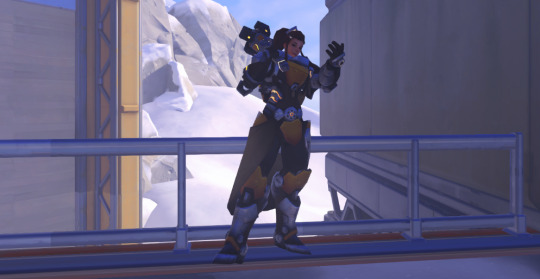
A lot of Brigitte’s tone and voice lines portray a person who loves to taunt her enemies, while trying to be optimistic with her team. Personally, I hate this, primarily when it’s done in combination with her abilities. After feeling cheated by getting killed by her powerful and easy-to-use abilities, she’ll usually follow up with a taunt or laugh, just to make you feel even worse about being killed. These bad manners aren’t uncommon in Overwatch (”ggez,” and things of that sort), but the fact that this is pretty much encouraged in terms of Brigitte is pretty awful.
In terms of trends in Overwatch (aka “Metas”), there’s plenty more to talk about. The last thing I’ll leave you with is this:
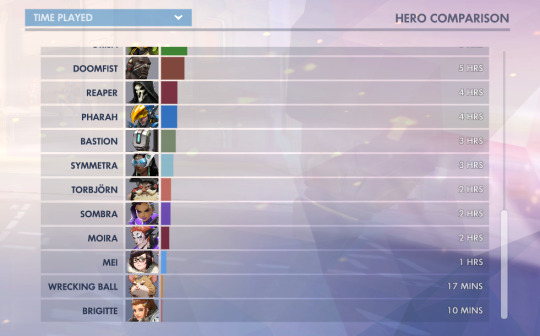
Brigitte is my least played character, and I intend to keep it that way. In fact, I’ve never actually chosen to play her, these 10 minutes were only in Mystery Heroes, where you have to be killed by an enemy to change heroes, and you have no choice who to play. In other words, I refuse to bring this much pain to my enemies, no matter how badly I may be losing. See? I have standards.
1 note
·
View note
Text
Graphics and Hardware
A pretty big part of playing games online is visual awareness, and this comes from your hardware (what you’re using to play the game, in my case my personal computer). In other words, having a half decent computer to play on can change how well you perform. Overwatch actually does a decent job of making most “setups” work well enough to play on, but how well exactly do the visual options work out, and how different do each of them look?
For a long time, I played on pretty old hardware, but it certainly wasn’t “unplayable.” However, there were many “stutters” with gameplay (maybe the game freezes for a split second during a fire fight and gets me killed, that kind of thing).

As you can see, there was a pretty visible increase in SR (skill rating) in my case once I upgraded hardware, meaning that I was being held back by this older computer. I got my new computer around mid-June, meaning in the middle of season 10. In the next 2 seasons, my SR went up pretty consistently, although I haven’t played competitively in awhile.
The reason for all of this is because with a newer and better computer, I was able to see a lot more of what’s going on in a match. While my old computer would start acting up during intense firefights, my new one could let me see everything that’s going on. Over time, this started to make a visible difference in my own performance.
youtube
Here’s a pretty good comparison between the two so you can see what I mean (just know that the screen you’re using has to be good enough, and your connection has to be able to load the 60fps video to see the difference).
In Overwatch, a lot of options are available for players to change how the game looks. In other words, the visual quality is more customizable than “low, medium, high.” Instead, many options are given, such as textures, shadows, shading, etc...

As you can see at the top, however, the option is available for players to simply choose low, medium, or high settings overall.
This level of customization is great for players, because it can cater to certain parts of their computers. If one part of their computer excels, then they can change settings to keep the game running well while making it look as good as possible. This is a very simple way of putting things, but just know that having these advanced options is very beneficial.
Now, let’s get to Overwatch’s graphics, and put these settings to the test. I went in game, found 3 different locations, and took pictures from the game with different settings. Below are the comparisons I made using each location.


This picture shows the textures very well. On the bottom part, you can easily see the different bolts and grooves on Genji’s robotic hand on higher settings, but these things are less clear on lower settings. This is also evident with the roof, but I’m more interested in what’s behind that. As you can see, the shadow of a doorway is present, and there’s no arguing that the shadow is much sharper on the higher settings, compared to the smooth shadows on lower settings.


This picture very clearly shows anti-aliasing at work, which is an effect used to get rid of the staircase-like look of pixels on a slanted object. Even from a far distance, you can see the pixelation on lower settings, while the red pole is pretty smooth on higher settings.


This comparison shows a huge difference in shadows. While the shadows on the left look like, well, shadows, the ones on the right look like blobs of light and darkness on the wall.
2 more comparisons can be shown in the same locations, which are the glow and also just the level of detail with higher settings.


On top of the obvious downgrade in terms of pixelation and vibrancy, the lower settings (bottom) are missing the sort of glow that emits from the green lights on Genji’s hands and shuriken. In some areas of the game, this visual effect can be stunning (beautiful) if put to work in the right lighting situations.


As you can see, under the car on the right, there's pretty much no shadow on lower settings. Also, there aren’t even boxes or a cone there, which just looks weird. Another thing to note is the shading in this comparison.
While the pillar in the middle of the photos looks about the same, the sign on the top left and the windshield of the van look way better with higher settings. Also, the anti-aliasing can really be seen with the front of the car, and with the slanted walls in the photos.
As you could tell by looking at all the comparisons, the biggest differences are seen when you zoom into any given photo, but even in game the differences are very noticeable. Whether or not you’re willing to give up framerate (a competitive advantage, shown in the video earlier) for this visual quality is up to you, but personally I enjoy increased performance rather than looks. Next week, I’ll be covering things like skill and balance in Overwatch.
2 notes
·
View notes
Text
Story and Lore
When you take a break from looking at Overwatch from a competitive perspective, you start to notice a lot more of the storytelling going on. Whether it be through voice lines and action in game (what I discussed last week) or short cinematics uploaded to YouTube, Blizzard works to improve gameplay, while developing their characters and story. Like I mentioned before, this is usually the type of thing you see on Tumblr (besides the community “shipping” characters together).
A lot of the story in Overwatch happens between the characters. Although some development occurs outside of hero interaction (i.e. “this person experiments on their own time with...”), most of it happens within the 28 heroes currently in the game. For example, Genji’s complicated history is made up by heroes like Hanzo, Mercy, and Zenyatta.

One of the strongest pieces of lore in Overwatch is, like I just mentioned, between Genji and a few other characters.
In the cinematic short “Dragons,” Blizzard tells us more about the history between Genji, and his brother Hanzo. This is done through a metaphor about 2 dragons, in which one of them kills the other (Hanzo kills Genji).
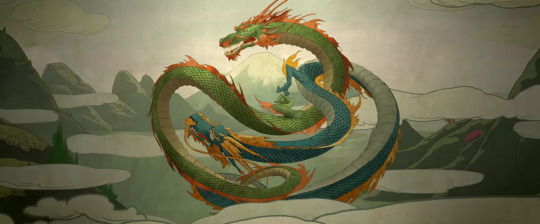
youtube
Genji’s story is, put very simply, a story about a man gaining his abilities back after death. Hanzo kills him due to complicated family “drama,” Mercy resurrects him, and Zenyatta helps him come to peace with his altered cyborg body. In game, his voice lines and actions reflect his goals of “honor,” almost constantly.
Lots of the lore in Overwatch is between 2 corporations, Overwatch and Talon.

As I mentioned last week, Talon’s main goal is to show that humanity is made stronger through conflict, and because of this they perform many violent acts. Overwatch’s goal is to protect civilian and military targets. Overwatch also had a privately owned section called Blackwatch, which was hidden from the public.
Many of the heroes in the game fall between these 2 groups. For example, Talon includes Moira (used to be in Blackwatch), Doomfist, Reaper, Widowmaker, and Sombra.

Likewise, Overwatch has many operatives. The older ones (in the past) included Soldier 76, Winston, Tracer, Ana, Reinhardt, and Mercy.

Talon and Overwatch had many clashes throughout their times, as well as many other interruptions. Many of these happened with Blackwatch, and caused multiple characters to switch sides.

In Overwatch’s Retribution event (PvE, I believe I mentioned it in the “Game modes” post), the players learn a lot more about Blackwatch and why it was split up. In one mission in Venice, the plan goes wrong. After this, the public learns about Blackwatch existence, which to an extant supports the downfall of Overwatch as a corporation.

Reaper, a.k.a. Gabriel Reyes, was the leader of Blackwatch. Moira, a geneticist was recruited to the team and went along with Reaper, McCree, and Genji to capture the leader of Talon. The plan goes wrong, and Reaper kills the person they were supposed to capture. Later on, Reaper and Moira both join Talon, and work against the organization they originally worked for.
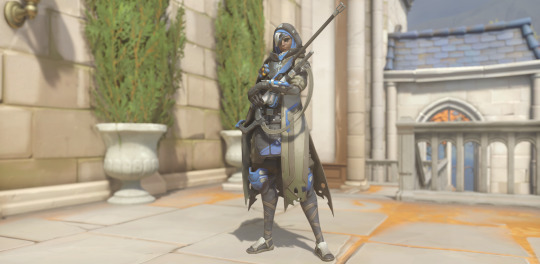
Ana, an operative from Overwatch, has quite a bit of story by herself. First, her daughter (Pharah) followed her footsteps of fighting in the pursuit of justice. However, this isn’t the life Ana wanted for her.
Also, in a sniper duel between Widowmaker and Ana, Ana hesitates to fire, and gets badly injured (the reason for the eye patch). In this incident, she survives, but leaves the rest of her team (Reinhardt, Soldier, etc...) to believe she’s dead. In fact, when both are chosen in game, Reinhardt says that he thought she was dead, and she said “That was for the best.”
At one point, the public opinion of Overwatch plummeted (aka. Blackwatch discovered, many more factors). Because of this, and an attack on their HQ, Overwatch was disbanded and was prohibited by law. In the game’s intro, Winston (gorilla scientist) calls the agents of Overwatch back together to continue their peacekeeping.
youtube
This works well for the game’s intro, because it gives a reason for the members of Overwatch (and Talon, too) to be in the same areas. In other words, this cinematic gives a reason for the gameplay to occur.

Tracer used to be a pilot, until she became victim of “chronal disassociation.” In simpler terms, she wasn’t stable in time, and would regularly disappear for seconds, or months. Winston built a device (visible on her chest) which would stabilize her in time, and allowed her to control this anomaly (thus, she has her abilities).

Shortly after she was recruited into Overwatch because of these abilities, the Uprising event occurred. In King’s Row (a map in the game) there was a Null Sector rebellion (a group of hostile omnics, aka mad robots). In this playable mission, Torbjorn (an engineer of Overwatch), Tracer, Reinhardt and Mercy work to liberate the city.
There are many more parts to the lore in Overwatch, but these are some of the most important parts I could think of. I definitely missed out on some events in the game’s story, and there are plenty of characters I didn’t mention (Junkrat and Roadhog’s crime spree, Mei’s personal situation, the attack of the Numbani airport, etc...), which I may cover in the future. As for next week, I will be covering hardware and more of the “coding” side of the game (how does it run?).
4 notes
·
View notes
Text
Character Design
When I began this blog, I wanted to see if anything on Tumblr matched the focus I chose. While there was plenty of content about Overwatch, I noticed that a lot of it was about the lore of the game. In other words, most of the blogs were about the stories and backgrounds of the characters in the game, not the game itself.
Anyone who’s watched a movie or played a story-based game knows that its hard for players to become attached to a character without good design. Overwatch, in my personal opinion, has this design.
Overwatch’s story comes from its heroes. Ever since the trailer was released in 2014, Blizzard began to build a story with a small selection of heroes.

In the trailer specifically, Winston, Reaper, Widowmaker, and Tracer made appearances, representing 2 organizations in the Overwatch universe.

Tracer and Winston (1st and 2nd) belonged to the Overwatch organization, while Reaper and Widowmaker were operators of Talon (3rd and 4th).
These rival organizations fought over their views. While Talon tried to show that “humanity is made stronger through conflict,” Overwatch protected military and civilian targets.
That’s enough lore for now, as that’s a huge topic for another day. For now, let’s focus more on character design in game, and how Overwatch creates immersion by showing that you’re actually playing as someone with personality.
One way the game creates character is through first person animations: things that the player can visually see while playing that character.
Bastion, a curious old war robot, is very naive and sort of “rusty.” His animations convey this by showing sloppily moving parts, suggesting years of wear and tear to the discontinued Bastion unit.

His reload animations tell us a lot about his movements. Parts of his arm move to make space, and everything is very orderly: he’s a machine running a line of code to perfectly reload his weapon.
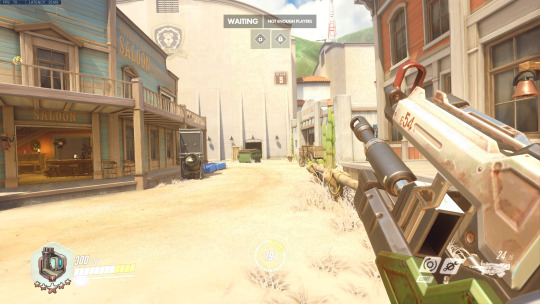
Roadhog is pretty much the opposite. He’s very much alive, and he doesn’t take much order into account with pretty much everything. His nature of destruction and generally not caring are shown pretty well in his animations.

In his reload, this is shown better than ever. While other heroes have a process to follow to reload their weapons, Roadhog slams a bunch of scrap and junk into his gun, and then continues to spray at his enemies with it.

My last example of this is Lucio, who’s a world famous DJ known for his groovy nature and optimism. Something worth noting is that he has very unique movement (his wall-riding), but even with regular walking he skates around at whatever the music he’s listening to suggests.

His reload animation also suggests this pretty well, by incorporating a little spin to his “capsule” in his left hand before putting it into the gun. If he was a hero similar to Roadhog, he’d probably just toss or slam it into his gun and continue on, but this pause to enjoy something small shows a lot in terms of what Lucio is all about.

Another way in which Overwatch conveys character deviation is through their voices (sadly, not many visuals can show this).

Orisa was designed to be extremely friendly and caring, and does it well. She’s definitely a “mom” of the game, especially when you take into account her voice lines. Things like “Get behind me!” and “My shield will protect you,” show this care, and overall she’s just a protecting hero.

On the other hand, Sombra isn’t looking to protect anyone. In fact, most of her voice lines consist of taunts for her enemies, or threats to other characters. In some interactions, Sombra is pretty rude to even the friendliest of Overwatch characters. She acts simply to accomplish her mission, like the members of Talon (who don’t really feel emotion).

Genji does things differently from both of the other 2 examples: he doesn’t protect anyone, but he also isn’t rude to them. Because of his past and his experiences with his brother Hanzo, his resurrection from Mercy, and his teachings from Zenyatta, Genji focuses on honor and accomplishing his mission to prove himself.
Because of all of these different interactions, there’s plenty for Genji to say to other characters. In the matches I play with him (after all, I’ve played him the most), he almost always talks to another character before the attacking team is released, because this is the quietest part of the match.

As shown, each character has their own personality, and completes their mission in vastly different ways. While heroes like Tracer and Lucio are generally friendly and optimistic, their positivity is “countered” by the pessimism and negativity of heroes like Widowmaker and Sombra. There’s plenty more to talk about in terms of character design, so I’ll definitely be referencing this and adding on with the game’s lore next week.
0 notes
Text
Abilities and Kit
In Overwatch, each character has their own set of abilities which are, for the most part, unique to that hero. Similarities in “kit,” or what abilities and features each hero has, are what create the trends in the game: shield tank, off-healer, flanker, etc... Let’s define what exactly kit is, and what kinds of play styles they give to heroes in the game. But first, what are the different abilities for all heroes?

Because Lucio is, on paper, a very complicated hero, we can use him to define the different types of abilities. Also, he has a rather unique play style, so he doesn’t really fit into the other categories I mention later.
In the photo, there’s a lot to look at: 2 weapon related abilities (in red), 1 without a cooldown (in green), 1 passive ability (in white), 1 regular ability (in yellow), and of course, 1 ultimate ability (in blue; a “signature” ability, extremely powerful and earned through playing well).
As with all other heroes, Lucio has a weapon: that weird looking boombox-gun on the left side of the photo. The 2 abilities on the far right (red) are the different ways Lucio can use that weapon. The top one blasts people away with a slow fire rate and a cooldown of 4 seconds, and the one on the bottom is regular shooting: just a little bit of damage if the projectile hits an enemy.


In green, is the ability Crossfade. This is a type of ability that doesn’t have a cooldown, because it switches between 2 modes. For Lucio, this decides whether he speeds his team up (top photo) or heals them (bottom photo). Another example of this type of ability would be with Bastion, when he switches in and out of his turret mode.
In yellow, is a very regular ability: you use it when you press the button, it lasts for a few seconds, then has a rather long cooldown (about 10-15 seconds in this case). Other regular abilities happen instantly, instead of lasting for a duration of time. For example, McCree’s Flashbang throws instantly and has a decently long cooldown.
In white, are passive abilities. Only some heroes have this, and it usually happens constantly when the hero is alive. In a way, this ability is sort-of in the background. For example, with Lucio, he can always ride off of walls, and Moira always regenerates her own health when she deals damage. For the most part, passive abilities don’t directly damage opponents, and instead benefit the hero with movement upgrades, health, slight offense advantages, etc...

Lastly, and somewhat most importantly, is the Ultimate Ability (in blue). Each hero has their own, and you earn it through playing well. While your ultimate charges slowly overtime, its charge time is primarily determined by how much damage or healing you deal. Basically, the better you’re playing, the more often your ultimate is ready. The rate at which your ultimate charges depends on who you’re playing, and therefore what ultimate it is (i.e. Junkrat’s Rip-tire charges faster than Soldier 76′s Tactical Visor). Ultimate abilities are a topic of their own, but all you need to know is that they’re a big part of the game, and they’re generally the strongest abilities in any kit.

Tracer is one of the more obvious examples of kit, as she’s a very simple hero. She has low health and is physically smaller than almost all other heroes, and teleports around enemies to evade attacks.
She only has 2 actual abilities, which let her teleport short distances (Blink), and let her regain health and leave the action for a moment (Recall).
These abilities make Tracer into a flanker, which means she runs behind enemies and tries to shoot from the sides of the fight. Because of this, you probably won’t find her standing on an objective with the rest of her team.

Her Ultimate, Pulse Bomb, supports this play style as well. She jumps in to the enemy team, throws the bomb, and teleports back out, hoping that she stuck the bomb to an important enemy. Since the bomb does 300 damage in a very small area, it generally will get 1 or 2 kills if the player aims their throw well.

Orisa is pretty much the exact opposite of tracer. Instead of running behind the other team, Orisa makes herself the center of her team by providing a large shield and pretty good protection on an objective. She has 3 abilities, which are “Halt!” “Fortify,” and “Protective Barrier.”
Her barrier is her main ability, and protects her team the most out of all of them. Fortify makes her resistant to multiple types of damage, and Halt! is a weird one: an orb shoots out of her robotic arm, and wherever it explodes, it pulls enemies together, and makes them unable to move during this pull.

As you can see here, 2 different abilities are being used: her barrier, and Halt! The barrier is the clear-blue wall on the right side, which only Orisa and her teammates can shoot through (excluding some attacks, such as punches and some “magical” abilities), and Halt! was used towards the top of the picture.
As you can see near the top, the health of the shield is shown, and if it isn’t broken after 20 seconds or so, then the shield disappears. In the same place, Halt! was used against those 2 training bots, which made them rise into the air. In game, this surprises enemies while making them easy targets, which can turn the tides of a team fight.

Mercy’s play style is different from both Orisa and Tracer. Instead of flanking or giving a shield, she (literally) flies between team mates, healing them pretty quickly. Although Mercy has been made increasingly worse with updates over time, she still remains a priority target because of her high levels of healing.
2 of her abilities, Guardian Angel and Angelic Descent, are both regarding her movement. Her Guardian Angel ability is available very quickly after using it, and lets her sort-of bounce between her team mates using her wings. With Angelic Descent, she can fall very slowly if she chooses to. This lets her stay in close range with team mates in the air.

The last of her regular abilities is Resurrect, and quite simply, allows her to revive one of her team mates from the dead, keeping them in the fight more often. Otherwise, that hero would have to run all the way back from a spawn point, which could be across the map.
Her Ultimate allows her to fly and increases her healing range. Something else I forgot to mention is that she can also increase a hero’s output damage if she doesn’t need to heal, making some Ultimate abilities even more devastating if used correctly.
These are just a few examples of heroes’ kit in Overwatch, and each of them are different in their own ways. As mentioned previously, there are some trends that determine the play styles of characters (i.e. Reinhardt and Orisa function similarly because of their huge shields), but these are basically just categories the community made up to “dictate” team composition. That being said, each hero is played differently, and understanding each of them and how they’re used is extremely beneficial, which makes this a huge part of improving in Overwatch.
2 notes
·
View notes
Text
The Various Game Modes
There are many different game modes in Overwatch, excluding Quick Play and Competitive Play. Many of these modes are included with limited time events, which are usually seasonal (winter, summer, etc.). Something else worth mentioning would be that these game modes are all in “The Arcade.” This is a more laid-back style of playing, and is where you access these game modes. Many of them are also available in custom games (private matches), where you play versus your friends with any settings you want.
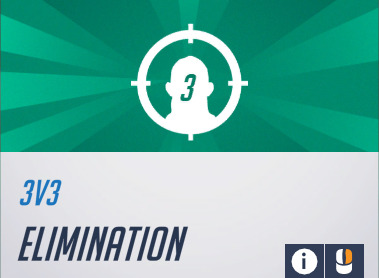
In this mode, the maps are limited to a much smaller number, and the maps themselves are much smaller (also mirrored, like the King of the Hill maps). Also, they’re generally unique to a few arcade game modes.
One of these maps is the Necropolis, and personally I enjoy playing on it. As you can tell, the map is a lot smaller and offers the same opportunities to people on both sides.
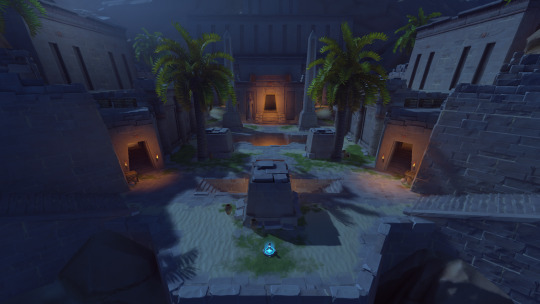
Each team is obviously made up of 3 people, and they fight over the course of a few minutes. Respawns are disabled, so each player gets 1 life per round. If at least one player is left alive on each team after this time, a point in the middle of the map unlocks and whichever team captures it wins the round, even if the enemies are still alive. If one team is entirely eliminated, then their opponents win.
There’s also another variation of this mode, which is 3v3 Lockout Eliminations. The rules are the same, except for one thing. After winning a round with a specific character, your team cannot pick that hero for any other round in that game. For example, if one team wins with Mercy, Roadhog, and Soldier 76, then that team can’t use any of those heroes regardless of who was playing who. However, the other team can still use those 3 heroes (until they win a round with them).
The scoring is best out of 5 rounds, so teams race to win 3 rounds.

A very similar game mode, 4v4 TDM is also played on smaller maps, but also includes various versions of other maps from the main game. For example, Hollywood is restricted to the middle third of the map and is available for play on this game mode.

The teams are made of 4 people, and hero choices are not limited like in 3v3 Eliminations (you just can’t have the same hero twice on 1 team, same as the main game). Respawns are enabled, so you can respawn as much as you need to.
Whatever team reaches 30 eliminations on the other team wins, but Mercy’s Resurrect ability subtracts one point from the other team’s score (personally, I dislike this feature, because teams can win just because they have a Mercy on their team).
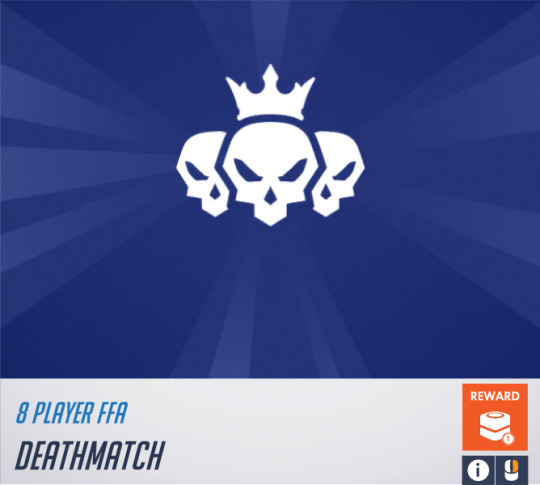
Very similar to Team Deathmatch, 8 Player Free for All is all about getting eliminations as fast as possible. 8 players play on small maps (same map pool as 4v4 TDM) and get as many “final blows” as possible. This mode was introduced with the map “Château Guillard,” specifically made for FFA.
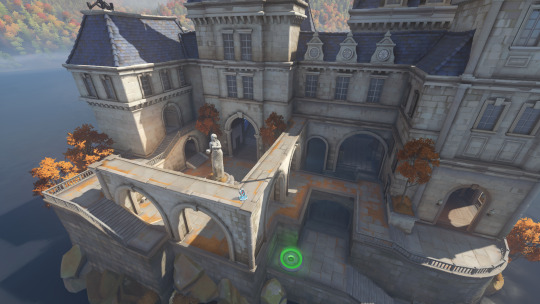
While eliminations include small contributions to kills in the main game, getting a “kill” in these deathmatch game modes means delivering the final blow on an enemy. Additionally, because 8 players are fighting against each other and every man is out for himself, this is one of the most hectic game modes in Overwatch.
Hero selection is not limited whatsoever, but damage heroes should generally do the best. However, some heroes like Winston, Moira, and Brigitte do surprisingly well in this game mode. This is because they can easily “steal kills.” This is done by doing a small amount of damage to finish off an enemy who was already weak. Many times, the enemy was already fighting someone or had just concluded a fight.
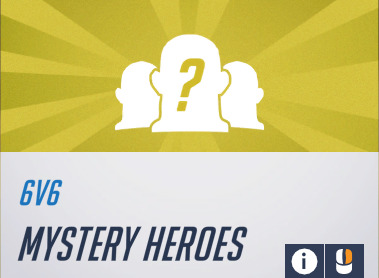
In mystery heroes, there’s only one difference from the regular game: every time you spawn in, you’re using a different hero, randomly selected. Ultimate abilities are reset every life, so the use of them is rather rare.
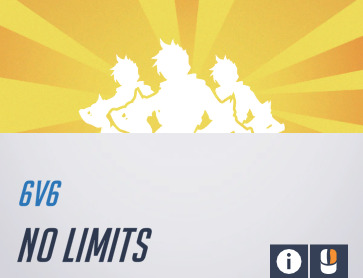
In no limits, it’s simple. Just like mystery heroes, the main rules of the game are the same, besides hero selection. In this mode, you can have any amount of one hero on a team.
For example, you can have 6 Lucios skating around a team of 3 Genjis and 3 Winstons all in the same match.
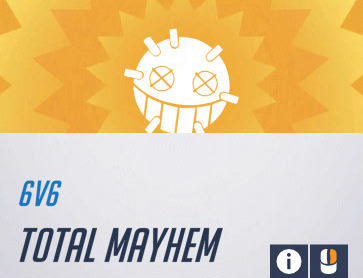
In total mayhem, a regular game takes place (regular hero selection, too), but pretty much everything is enhanced. All heroes double their health, ultimate abilities charge faster, and abilities are only on “cool down” for half the time. These games are usually very hectic, and can last for a long time because of increased survivability.
Now, let’s go over some limited time event game modes. As mentioned before, these are usually seasonal, and are featured in the Summer Games, Halloween Terror, Winter Wonderland, and the Lunar New year event.
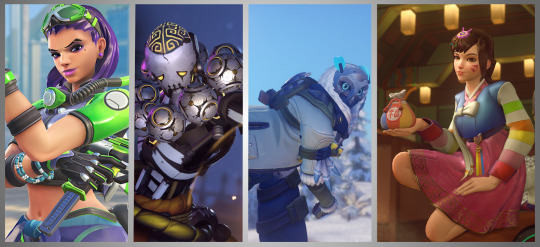
One of these game modes, which recently ended, is Lucioball.
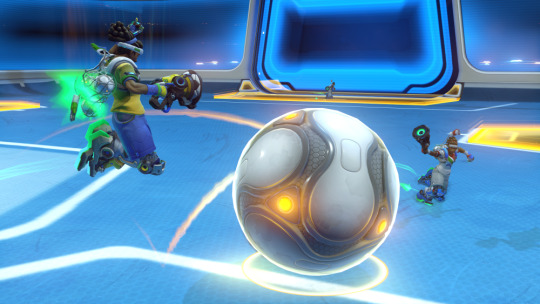
Lucioball is very simple, and is very similar to Rocket League. 3 Lucios spawn on each side of the field and try to play soccer with a giant ball, punching it and shooting it across the field. It’s pretty much just soccer, and that’s why it’s included in the Summer Games event, which lasts around mid August.
Halloween Terror’s iconic event is Junkenstein’s Revenge, which is PvE (wave survival, 4 players vs. bots).
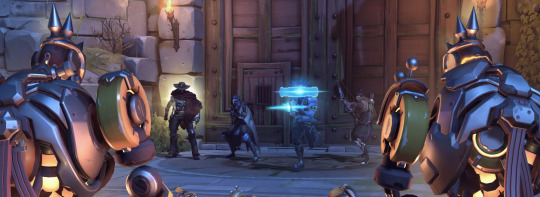
This game mode has multiple different variations, including difficulty (beginner, expert, etc.). There is also an endless version, where all heroes are available for selection. In the regular mode, only 4 heroes are available: Soldier 76, Hanzo, Ana, and McCree. Halloween Terror begins in early October and ends on the 1st of November.
In Winter Wonderland, 2 events are available. The first one to be introduced was Mei’s Snowball Offensive, and the next year Yeti Hunter was available.

This game mode is pretty much just 6v6 eliminations (1 life per round), but with a 1 shot 1 kill system of snowball shooting, which can be reloaded around the map (an old and weird game mode, personally I didn’t like it so I don’t know much about it).

Yeti Hunter was a 5v1 game mode, the lone player being a giant yeti (a Winston cosmetic) with a lot of health. The 5 Meis have to hunt the Yeti down, otherwise he’ll have chances to eat meat around the map and become stronger. If the Yeti dies, he loses, but he wins if he gets 5 eliminations on the Mei team (respawns enabled, which means that 1 Mei can die 5 times and lose for the team).
Lunar New Year, lasting between January and March, brought us Capture the Flag, which has changed a lot between its release and right now. There have been many gameplay changes, as well as map changes.

Quite simply, each team has a flag at their spawn, and the other team must take it and bring it back to their spawn. While there are many more specific and unimportant rules, I haven’t played (or enjoyed) the game mode long enough to know all of these. With the introduction of the map Ayutthaya, the game mode was made available on that map for most of the year. However, the game mode is also played during the event on many of the King of the Hill maps, the most famous of these being Lijiang Tower, which makes sense because it is a Chinese holiday. The map is decorated with Chinese lanterns and many other lighting effects during this time.
While there are even more game modes after all of these, most of them are sort of spinoff game modes, or are just map restrictions (and this post is already long enough). For example, whenever a new map comes out (like Busan, not even a week ago), that map is available in its own category of the Arcade.
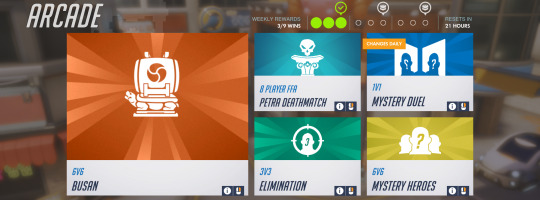
As you can see, Petra Deathmatch is currently available in the Arcade, but it’s really just 8 Player FFA limited to that 1 map. Also, Mystery Duel is a very similar game mode to 3v3 Eliminations, but incorporates Mystery Hero rules (2 players spawn on opposite sides of a small map with the same character, and duel with Elimination game mode rules).
The last notable thing about the event game modes would be that all of them are available in the few weeks of the Anniversary event, which lasts from the middle of May to the middle of June. In the Spring, additional PvE game modes are available (Retribution and Uprising), which are very story based. While I personally enjoyed these, I wouldn’t really consider them game modes of Overwatch.
Next week, I’ll be covering abilities and kit, and how they may determine play styles for different heroes (mentioned a few times in my 2nd post, “Team Composition”).
1 note
·
View note